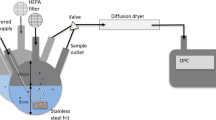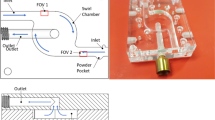Abstract
The stability of agglomerates is not only an important material parameter of powders but also of interest for estimating the particle size upon accidental release into the atmosphere. This is especially important when the size of primary particles is well below the agglomerate size, which is usually the case when the size of primary particles is below 100 nm. During production or airborne transportation in pipes, high particle concentrations lead to particle coagulation and the formation of agglomerates in a size range of up to some micrometers. Binding between the primary particles in the agglomerates is usually due to van der Waals forces. In the case of a leak in a pressurized vessel (e.g. reactor, transport pipe, etc.), these agglomerates can be emitted and shear forces within the leak can cause agglomerates to breakup. In order to simulate such shear forces and study their effect on agglomerate stability within the airborne state, a method was developed where agglomerate powders can be aerosolized and passed through an orifice under various differential pressure conditions. First results show that a higher differential pressure across the orifice causes a stronger fragmentation of the agglomerates, which furthermore seems to be material dependent.








Similar content being viewed by others
References
Anselmann R (2001) Nanoparticles and nanolayers in commercial applications. J Nanopart Res 3:329–336
Blum J (2006) Dust agglomeration. Adv Phys 55:881–947
Chen S-C et al (2007) Particle loss in a critical orifice. Aerosol Sci 38:935–949
Dannehl M et al (2007) Nanoparticle synthesis by gas-dynamically induced heating and quenching. European aerosol conference 2007, Salzburg, Abstract T09A039
Fonda F et al (1999) Resuspension of particles by aerodynamic deagglomeration. Aerosol Sci Technol 30:509–529
Froeschke S, Kohler S, Weber AP, Kasper G (2003) Impact fragmentation of nanoparticle agglomerates. Aerosol Sci 34:275–287
Gnedovets AG, Kul’batskii EB, Smurov I, Flamant G (1996) Particle synthesis in erosive laser plasma in a high pressure atmosphere. Appl Surf Sci 96–98:272–279
Grzona A et al (2009) Gas-phase synthesis of non-agglomerated nanoparticles by fast gas dynamic heating and cooling. In: Hannemann K, Seiler F (eds) Shock waves, 1st edn. Springer, Berlin
Hamaker HC (1937) The London—van der Waals attraction between spherical particles. Physica IV:1058–1072
Hinds WC (1999) Aerosol technology: properties, behavior, and measurement of airborne particles, Chap. 12: Coagulation, 2nd edn. Wiley, New York
Kaur IP, Agrawal R (2007) Nanotechnology: a new paradigm in cosmeceuticals. Recent Pat Drug Deliv Formul 1:171–182
Kurkela JA, Brown DP, Raul J, Kaupinnen EI (2008) New apparatus for studying powder deagglomeration. Powder Technol 180:164–171
Lian G, Thornton C, Adams MJ (1993) A theoretical study of the liquid bridge forces between two rigid spherical bodies. J Colloid Interface Sci 161(1):138–147
Liz-Marzán LM (2004) Nanometals: formation and color. Mater Today 7:26–31
Maynard AD (2007) Nanotechnology: the next big thing, or much ado about nothing? Ann Occup Hyg 51:1–12
Megias-Alguacil D, Gauckler LJ (2009) Capillary forces between two solid spheres linked by a concave liquid bridge: regions of existence and forces mapping. AIChE J 55(5):1103–1109
Panyam J, Labhasetwar V (2003) Biodegradable nanoparticles for drug and gene delivery to cells and tissues. Adv Drug Deliv Rev 55:329–347
Quinten M (2001) The color of finely dispersed nanoparticles. Appl Phys B 73:317–326
Rabinovich YI, Madhavan SE, Moudgil BM (2005) Capillary forces between two spheres with a fixed volume liquid bridge: theory and experiment. Langmuir 21(24):10992–10997
Reeks MW, Reed J, Hall D (1988) On the resuspension of small particles by a turbulent flow. J Phys D 21:574–589
Russel LM, Flagan RC, Seinfeld JH (1995) Asymmetric instrument response resulting from mixing effects in accelerated DMA-CPC measurements. Aerosol Sci Technol 23:491–509
Sator N, Mechkov S, Sausset F (2008) Generic behaviours in impact fragmentation. Europhys Lett 81(44002):p1–p6
Schulz J et al (2002) Distribution of sunscreens on skin. Adv Drug Deliv Rev 54:157–163
Seipenbusch M, Toneva P, Peukert W, Weber AP (2007) Impact fragmentation of metal nanoparticle agglomerates. Part Part Syst Charact 24:193–200
Siddiquey IA et al (2008) Control of the photocatalytic activity of TiO2 nanoparticles by silica coating with polydiethoxysiloxane. Dyes Pigments 76:754–759
Soppimath KS et al (2001) Biodegradable polymeric nanoparticles as drug delivery devices. J Control Release 70:1–20
Thornton C, Yin KK, Adams MJ (1996) Numerical simulation of the impact fracture and fragmentation of agglomerates. J Phys D 29:424–435
Zimmermann I, Eber M, Meyer K (2004) Nanomaterials as flow regulators in dry powders. Zeitschrift f Phys Chem 218:51–102
Acknowledgement
The financial support of this study by the German Ministry for Education and Research (BMBF) within the NanoCare project is gratefully acknowledged.
Author information
Authors and Affiliations
Corresponding author
Rights and permissions
About this article
Cite this article
Stahlmecke, B., Wagener, S., Asbach, C. et al. Investigation of airborne nanopowder agglomerate stability in an orifice under various differential pressure conditions. J Nanopart Res 11, 1625–1635 (2009). https://doi.org/10.1007/s11051-009-9731-x
Received:
Accepted:
Published:
Issue Date:
DOI: https://doi.org/10.1007/s11051-009-9731-x




